

Ethereum has become a cornerstone for DeFi projects and NFTs, significantly advancing blockchain adoption alongside its scalability solution, rollups.
Rollups like Optimism and Arbitrum enhance Ethereum’s scalability by processing transactions off-chain and using Ethereum’s security, with initiatives like EIP-4844 making these solutions even more cost-effective.
Challenges within the Ethereum ecosystem include fragmentation of liquidity and inconsistent security measures among different rollups, necessitating innovative solutions for better interoperability and synchronization.
Initia, a Cosmos-based blockchain, aims to create an interconnected rollup ecosystem with unique economic, security, and liquidity features, distinguishing it from Ethereum with its enshrined sequencer and shared liquidity hub.
Initia’s future growth plans include the launch of its mainnet and the development of various DeFi, social, and NFT projects, potentially positioning it as a favorable option for launching rollups due to its user-centric and interconnected infrastructure.
Ethereum, one of the first smart contract blockchains, has served as the basecamp for primitive dapps in the crypto industry. Leading projects, such as Uniswap, MakerDAO, AAVE, EigenLayer, Lido, Ethena, and Curve Finance, have Ethereum as a home and have built the important primitives. Along with the NFT market, these DeFi primitives have been the main driver for the adoption of crypto, and have attracted new users to onchain.
Another notable innovation within Ethereum is rollups, which are paving the way for scalability through diverse execution environments and customizations. Projects like Arbitrum, OP-Mainnet, zkSync, Starknet, Mantle, and other rollups have expanded Ethereum's functionality and scalability by leveraging the Ethereum security. As some of the early rollups, Optimism and Abtrium started to provide their codebase to allow others to launch their own customized rollups, the number of rollups are increasing, according to l2beat, more than 100 rollups are set to be live soon.
Ethereum's path now involve various stakeholders, including validators, Ethereum researchers, DeFi dapps, and social dapps, making it undeniably the leading research and experimental hub in the overall blockchain ecosystem. While this is Ethereum's strength, some stakeholders, for example rollup developers, may find their voices less represented in the core infrastructure. This raises the question: what if Ethereum had been developed specifically for rollups? What might have been added and implemented?
This is where Initia, an L1 blockchain with its rollup ecosystem, comes in. Initia is developing primitives to make its own rollup ecosystem more economically aligned and leverage its settlement layer for rollup such as shared liquidity, shared security, shared interoperability, native oracle, multi-token staking (i.e USDC as staked asset and gas fee), etc. This interwoven nature between the settlement layer (Initia L1) and diverse rollups (Minitia L2), puts Initia to be the “Interwoven Network of Rollups.”
Before diving into how Initia operates, and what lies ahead for Initia, let’s first look into what the Ethereum ecosystem is like.
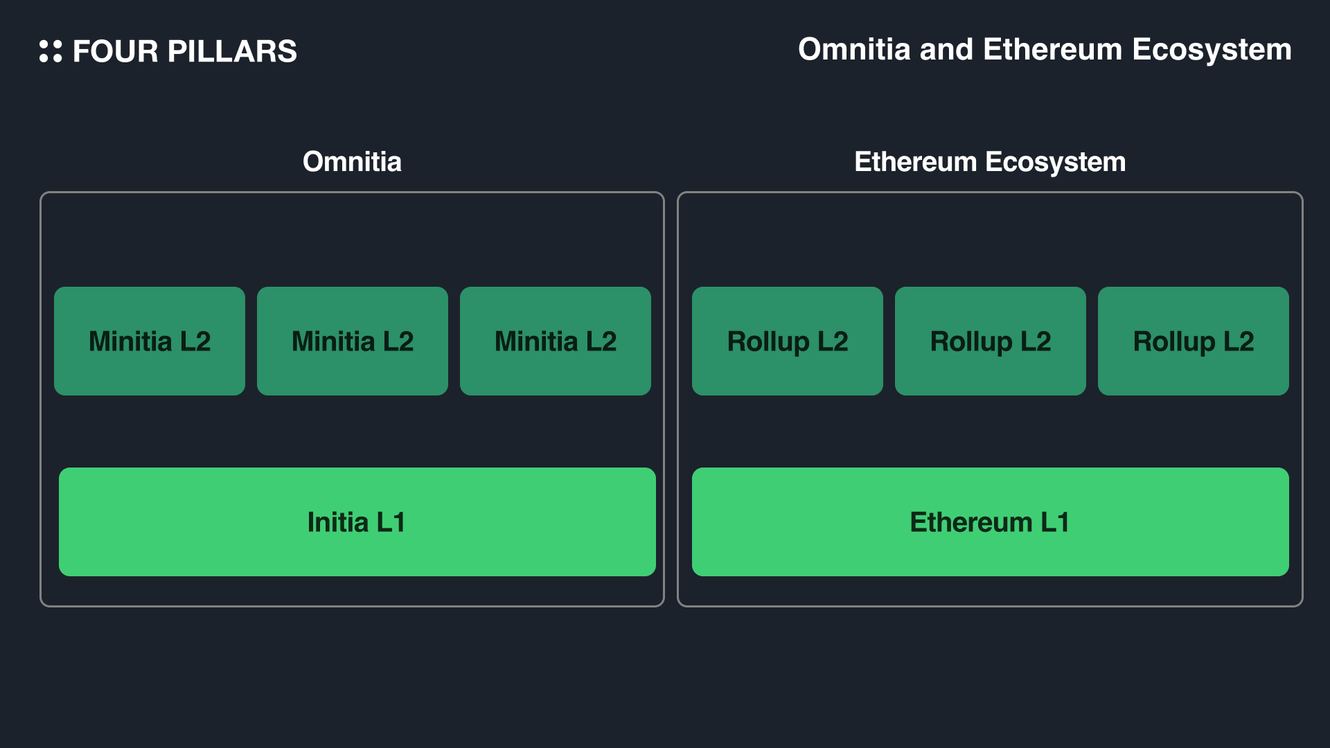
When we think of Ethereum, rollup is an essential component that complements and scale the Ethereum ecosystem. As jingyi from Optimism said, “Rollup” has been the new form of a smart contract for Ethereum. As rollups have been one of the driving force of expanding Ethereum, its roadmap has also had implementation to make rollups be better operated. For example, EIP-4844, also known as Dank Sharding, has been implemented to provide a new data publishing storage, for cheaper operation of rollups.
Apart from this, lets see what kind of other developments were present in the past developments of Ethereum.
Ethereum envisions itself as the settlment layer for global coordination, supporting different applications and being accessible to all users. The necessity for this vision arose from high gas fees, highlighting the need for Ethereum to balance decentralization, security, and scalability. Ethereum has a "rollup-centric roadmap" where rollups, not the Ethereum mainnet, will be responsible for scaling and handling most user transactions. However, to have the neutrality of Ethereum, not many developments for rollup are present in the Ethereum roadmaps.
Let’s look into what kind of EIP and developments in the Ethereum community are active for rollups.
1.1.1 EIP-4844 and Dank Sharding
A key development in the “Surge Phase” of Ethereum was the implementation of proto-danksharding (EIP-4844) in the recent Dencun upgrade on March 13, 2024. This introduced "blob" transactions that reduce data storage costs for rollups, making rollup transactions cheaper.
To achieve the scaling target, Ethereum is also implementing several technical improvements. These include data availability self-healing, which allows the network to recover missing data necessary for rollups, and PeerDAS, a data availability sampling network construction aimed at improving Ethereum's DA scale while minimizing workload. Danksharding is another crucial development, designed to make Ethereum transactions much cheaper and faster by processing bundled transactions from layer two rollups without storing all their data permanently.
1.1.2 Based Rollup - Leveraging Ethereum Validators
Based rollups, also known as L1-sequenced rollups, are a type of Layer2 scaling solution for Ethereum that rely on the Layer 1 blockchain for transaction sequencing. In this model, the next Ethereum L1 block proposer can include the next rollup block as part of the L1 block, collaborating with L1 searchers and builders. However, block building itself is done by L2 builders, which means tha it won’t increase the overload of L1 validators.
The integration of based rollups with Ethereum L1 offers several advantages. They eliminates the need for a separate sequencer, simplifying the architecture and reducing costs associated with sequencer signature verifications.with zero gas overhead for sequencer signature verifications. Additionally, they improve economic security by directing MEV to the L1. However, based rollups also have limitations, such as limited MEV income and dependency on Ethereum's block time for transaction confirmations.
Examples like Taiko's Based Booster Rollup (BBR) demonstrate the practical implementation of this concept, utilizing Ethereum's L1 validators for sequencing.
1.1.3 Statelessness and State Expiry - Better Storage for Rollups
Statelessness and state expiry are two important concepts being developed to address Ethereum's storage challenges and improve scalability. Statelessness refers to a system where nodes don't need to store the full state data, instead relying on "block proposers" to include state data hashes in block headers. This allows most nodes to operate with minimal storage requirements, verifying blocks by cross-referencing the hash against data stored by block proposers.
State expiry, on the other hand, involves removing state data that hasn't been accessed recently from the active state. This approach divides the blockchain into time periods (e.g., one year) and allows nodes to prune old, inactive state data at the start of each new period. State expiry would reduce the amount of data nodes need to store to a more manageable size, estimated at around 20-50 GB.
These developments will benefit rollups by reducing the storage burden on nodes, statelessness and state expiry will make it easier and more cost-effective to run rollup infrastructure. Additionally, as rollups rely on the base layer for data availability, the implementation of these technologies will enhance the efficiency of data storage and retrieval, further optimizing rollup operations.
The Ethereum rollup landscape is diverse and experimental, with projects exploring various proof systems and execution environments. As the technology matures, we can expect further advancements in more cheap, efficient, and decentralized proof systems. Also another notable trend is on AltVM, the diverification in the execution enviornment. Let’s look into the current landscape of rollups on Etheruem, based on the four core layers and supplementary components like interoperability.
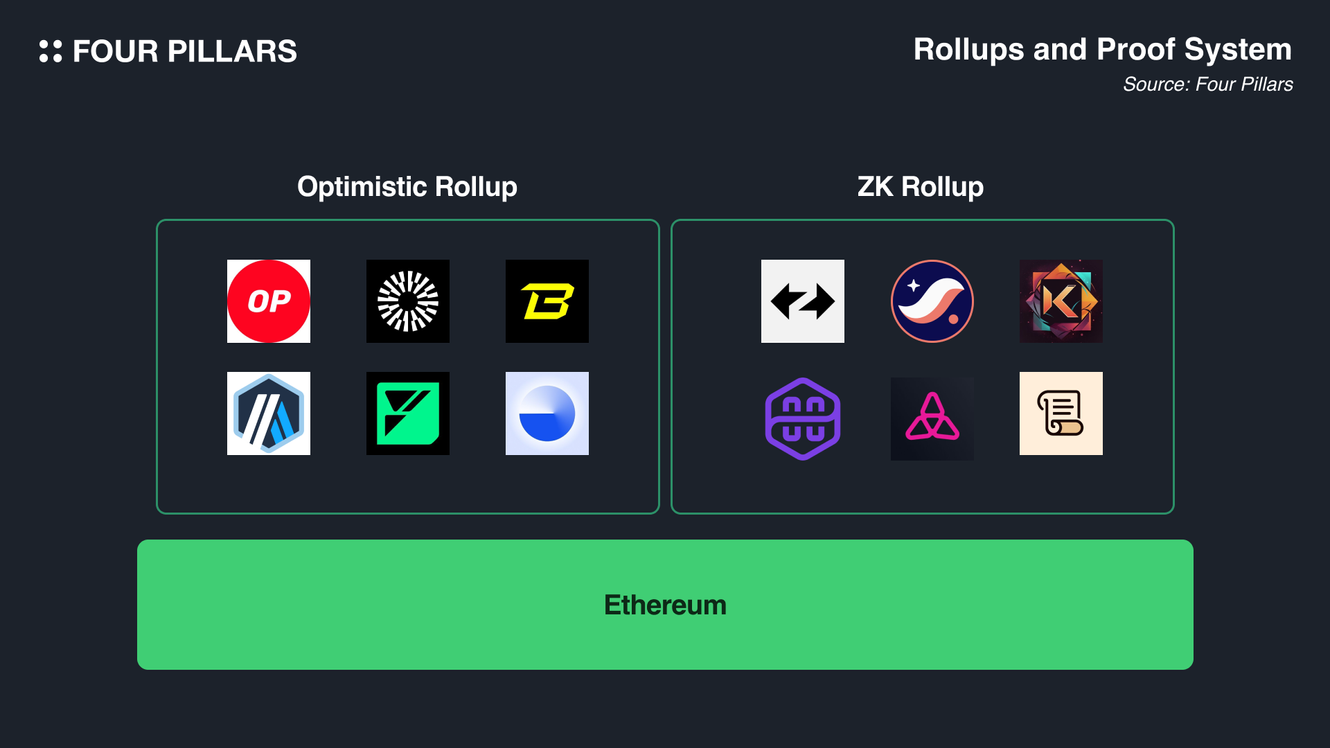
Source: L2Beat and Four Pillars
1.2.1 Execution Layer
The execution layer of a rollup is responsible for processing transactions and updating the state of the rollup, separate from the main Ethereum network. This layer receives transactions from users, combines them into blocks, and executes them according to the rollup's virtual machine. In 2023, most of the rollups had EVM as the execution environment. However, there have been lots of experiments, inlcuding having Solana Virtual Machine (SVM), WasmVM, and MoveVM as the alternative.
1.2.2 Proof System
The proof system of a rollup determines how state changes are validated and secured, separate from the main Ethereum network. This layer uses different models depending on the rollup type. Optimistic rollups like Arbitrum and Optimism employ an optimistic execution model, assuming transactions are valid until proven otherwise through fraud proofs. This model supports high throughput and compatibility with Ethereum's established infrastructure. On the other hand, ZK rollups like zkSync, Loopring, and StarkNet utilize zero-knowledge proofs to verify transactions off-chain prior to submitting compressed proofs to the Ethereum mainnet. This model offers enhanced scalability and privacy, though it might face limitations concerning smart contract functionality.
1.2.3 Data Availability Layer
The Data Availability layer of a rollup ensures that recent transaction batches are up-to-date and shared among participating nodes and the sequencer. This layer was traditionally stored as calldata in Ethereum. However, due to the high cost of calldata, alternative Data Availability providers have emerged to allow for cheaper operation. These include AvailDA, EigenDA, Celestia, EIP-4844 (Blobspace), and rollup framework-specific providers such as zkPorter for zkSync and Redstone for OP-Stack rollups.
1.2.4 Connectivity Layer
The ecosystem's connectivity layer currently relies on third-party solutions. This layer involves intermediaries such as market makers, solvers, or independent liquidity pools in each rollup to facilitate asset movement. Interoperability poses a significant challenge as it requires support from third-party projects like Layerzero and Axelar. The support for all rollups is complicated due to the centralized operation of current sequencers, which complicates trust assumptions.
Projects that are trying to address like shared sequencers, prove aggregator, based sequencing are still in an early phase, and need to be tested to be compatible to work with the current rollups.
1.3.1 Fragmentation of Liquidity and State
Since rollups rely on its dedicated set of sequencers, and have its own state, it is difficult to have a synchronization in terms of execution and liquidity, making the rollups fragmented. There need to be other ways to make the interconnectivity between rollups and Ethereum more secure and reliable. Currently, this is done by third-party projects like layerzero for messaging, lifi for liquidity aggregation through dex and bridge aggregation.
1.3.2 Different Security Measures
Most of the current rollups are centralized, a single sequencer handle transactions and generate proof for the state changes. Also, as the proof system is different between other rollups, they can’t trust each other. This makes seamless interoperability very difficult.
1.3.3 Trust Issues of Oracles and Data Availability
The rollup ecosystem faces significant challenges related to data availability and oracle trust. With state being split across multiple data availability (DA) options, ensuring consistent and reliable access to information becomes complex. This kind of oracle feed and DA need to be each supported in rollups and this fragmentation of data and limited access to crucial financial tools hinders the seamless operation and integration of rollups within the broader Ethereum ecosystem.
The architecture of Initia L1, has been built from the ground up for rollups. Basically, Initia is a Cosmos-based L1 blockchain, powered by MoveVM, designed to serve as a settlement layer for deploying and customizing interwoven rollups called Minitia L2s. Its key focus is on providing an interconnected and secure environment for the rollups. Each rollups can have varying economic structures, consensus mechanisms, programming languages, and application logic. It currently supports EVM, WasmVM, and MoveVM for Minitia L2 execution environment. Together, with Initia L1 and Minitia L2s, it forms a interwoven ecosystem, called Omnitia.

Source: Initia (Layer 1) | Initia Docs
Initia L1 acts as the orchestrator of security, liquidity, and interoperability for the ecosystem. Initia is also a Cosmos-SDK blockchain but has modification in terms of the economics and smart contract. Other than INIT token, which is the native token of Initia, USDC (when paired with INIT as enshrined liquidity and whitelisted) can be used to secure the blockchain, and can be used for a gas token. Also, the economic programs like VIP and kickback make the incentive aligned within the overall ecosystem. Another unique feature of Initia is the that utilize MoveVM for the smart contract functionality. This is done to make the L1 chain secure, since move has a formal verification within the language and other security measure to make the smart contract secure. It is also the first Cosmos blockchain to support MoveVM.
2.1.1 Omnitia Liquidity Hub
One of the unique features of Initia's L1 architecture is the Omnitia Liquidity Hub, which is enabled by a system called Enshrined Liquidity. This built-in DEX operates in a manner similar to platforms like Balancer, supporting weighted and stableswap pools. It facilitates the trading and yield generation of the native INIT token paired with other whitelisted tokens, such as INIT-USDC and INIT-stETH, without being confined to strict 50-50 ratio requirements.
This setup fortifies the liquidity base on L1, enabling dynamic usage of assets that would typically be locked in staking, thus enhancing both trading and staking yields. Moreover, the Minitia Router feature allows for seamless token movement across different Minitias, promoting liquidity sharing within the ecosystem.

Source: Minitia (Layer 2) | Initia Docs
Minitias are what Initia calls its Layer 2s, which is built with Minita Framework, that is built with a custom VM thath supports MoveVM, EVM, and Wasm VM.
2.2.1 Minitia L2 Framework - OPinit Stack
The OPinit Stack is a framework to build Minitia L2 with an Optimistic Rollup form of a Bedrock spec of OP-Stack. It also has an IBC protocol for the token transfer and message passing between L2 and L1. This also enables seamless communication with different VM and token standard, as it the underlying OPinit Stack framework is built upon Cosmos-SDK.
Central to the OPinit Stack are two critical Cosmos modules: OPHost and OPChild.
OPHost acts as the foundation of the stack, providing functionalities that facilitate the creation and management of an OP Bridge, which is crucial for cross-layer transactions. It also integrates Initia's L1 governance model, enabling modifications to address roles such as operators and challengers through governance proposals. The OPHost module maintains transaction batches from L2 as transaction indexes, ensuring efficient data logging and retrieval akin to Ethereum’s calldata mechanism.
The OPChild module further complements OPHost by addressing the specific needs of L2 operations. For example the validator oversight and token transfers.
2.2.2 CosmosSDK and Interoperability
The CosmosSDK forms the foundation of every Layer 2 (L2) on Initia. This versatile framework allows for the creation of unique blockchains, such as Osmosis, Berachain, Celestia, Injective, and Sei. By implementing a full CosmosSDK chain as a rollup, Minitias gain significant customization options, including:
Modifying chain operations
Altering transaction processing and ordering
Enabling multiple gas types
Additionally, each Minitia comes with built-in support for Inter-Blockchain Communication (IBC). IBC serves as the standard messaging layer among CosmosSDK chains, facilitating token bridging and cross-rollup contract interactions.
2.2.3 Decentralized Sequencers
Initia's MiniMint sequencer incorporates the CometBFT consensus mechanism (formerly known as Tendermint). This feature allows Minitias to operate multiple sequencer nodes by default, thereby reducing centralization risk.
2.2.4 MultiVM
Initia offers L2s a choice between three integrated Virtual Machines (VMs) on the Minitia Stack:
Initia's MoveVM
Initia's EVM
WasmVM (the standard VM on Cosmos)
Both MoveVM and EVM are new implementations on the CosmosSDK, specifically designed to support IBC.
2.2.5 Celestia DA
Initia designates Celestia as the official Data Availability (DA) layer for all Minitias. This enables state sharing and validation within a specialized layer.
2.2.6 Oracles
Initia utilizes its L1 validator set to provide fresh price data to the chain with each block, which they utilize Slinky. It employs a relaying system with L2 transaction prioritization to deliver these oracle updates to L2s without requiring external Oracle integration partners.
2.2.7 Native USDC and CCTP
Minitias can directly access Native USDC and Circle's Cross-Chain Transfer Protocol (CCTP) through: IBC, a specialized x/forwarding module, and Noble blockchain which is the native USDC issuance token.
This setup allows rollups to onboard native stablecoins into their chains in a single transaction, without slippage, by leveraging Circle's CCTP bridge.
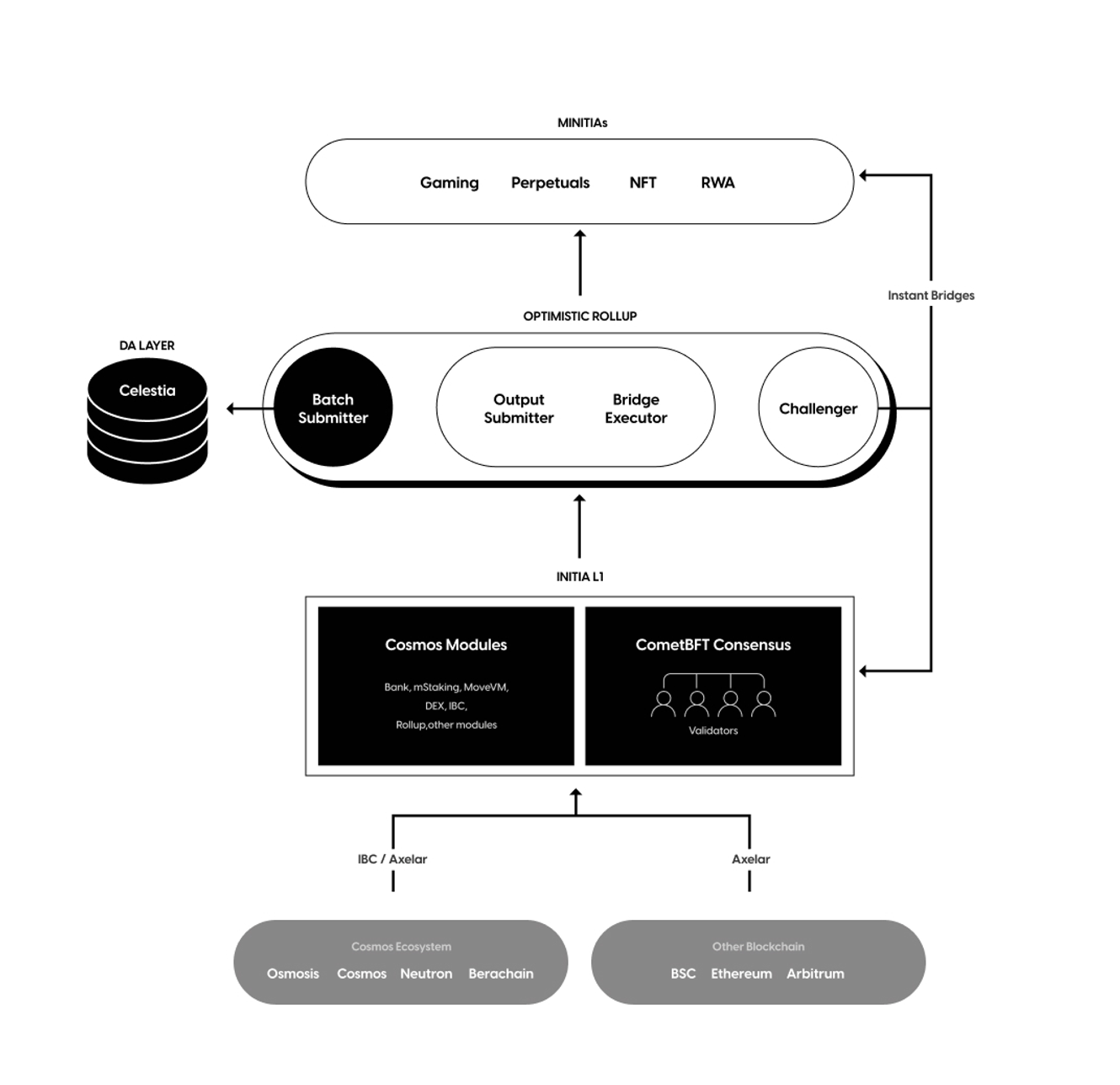
Source: Omnitia Architecture | Initia Docs
Omnitia is a comprehensive ecosystem that includes both Layer 1 Initia and Layer 2 Minitia. Within Omnitia, there are strong alignment among Initia, and Minitia L2s, in terms of security, interoperability, and economic. Let’s look into this.
2.3.1 Security Alignment
OSS (Omnitia Shared Security): In the event of fraudulent activity within an L2, the L1's validator set steps in to resolve disputes, with the aid of Celestia light nodes integrated into the validator nodes. This architecture ensures that Minitia L2 is safeguarded with additional external verification as well.
2.3.2 Interoperability Alignment
IBC: It enables Initia to facilitate secure and trustless communication between blockchains in the Cosmos ecosystem, supporting not only token and NFT transfers but also other cross-chain interactions through ICA (Interchain Account). Also this is enabled between Minitia L2s, making native interoperability possible. Since, the validators of Initia L1 also acts as a sequencer, the connection is secure among Omnitia ecosystem.
2.3.3 Economic Alignment
Vested Interest Program (VIP): It is a mechanism designed to foster ecosystem-wide growth and cohesion. By enabling Layer 2 economic activities to directly contribute to the value accrued by all participants, VIP aligns incentives across the network. This program not only promotes economic activity on Layer 2 solutions but also creates compelling use cases for the INIT token, positioning it as a fundamental asset in a multichain environment. Unlike the fragmented nature of some blockchain ecosystems, VIP ensures that INIT becomes an integral part of every Layer 2, promoting system-wide unity.
Kickbacks: Kickbacks in the context of the Initia blockchain refer to a portion of the transaction fees or rewards that are returned to participants as an incentive for their activity at the smart contract level. For instance, a portion of the fees collected from transactions could be redistributed to users who stake their tokens or provide liquidity.
2.3.4 Product Alignment
Initia has undertaken a comprehensive rebuild of its product stack , aiming to create a consistent user experience across all rollups, regardless of their individual uniqueness. This initiative is crucial as the industry moves towards a future with potentially thousands of rollups, where a simplified and unified user interface will be instrumental in helping users navigate and understand how to use various products. The consistency across rollups will be a significant factor in enhancing user adoption and interaction within the multichain ecosystem.
To achieve this goal, Initia has developed a suite of interconnected products. These include the Initia App, which serves as the central hub for all L1 activities; Initia Usernames, an ENS-like system usable across all L2s with the same address; Initia Wallet and Wallet Widget, which provide a native wallet solution and enable connections to various wallet types; and the Initia Bridge and Bridge Widget, designed to aggregate routes across multiple chains and simplify the bridging process. These products collectively aim to lower entry barriers, improve interoperability, and streamline the user experience across the entire multichain landscape.
In section 1 and section 2, we looked into Ethereum ecosystem, and Omnitia where both have an infrastructrue for rollup. In this part, lets put these two ecosystem together and see how they differentiate.
Ethereum is the universal settlement layer, acting as a hub for dapps and rollups, but keeping its neutral state in the overall development. So, enshrining MEV or sequencing is being avoided in the ecosystem. However, Initia has some enshirned components to provide the best experience, but keeping neutrality.
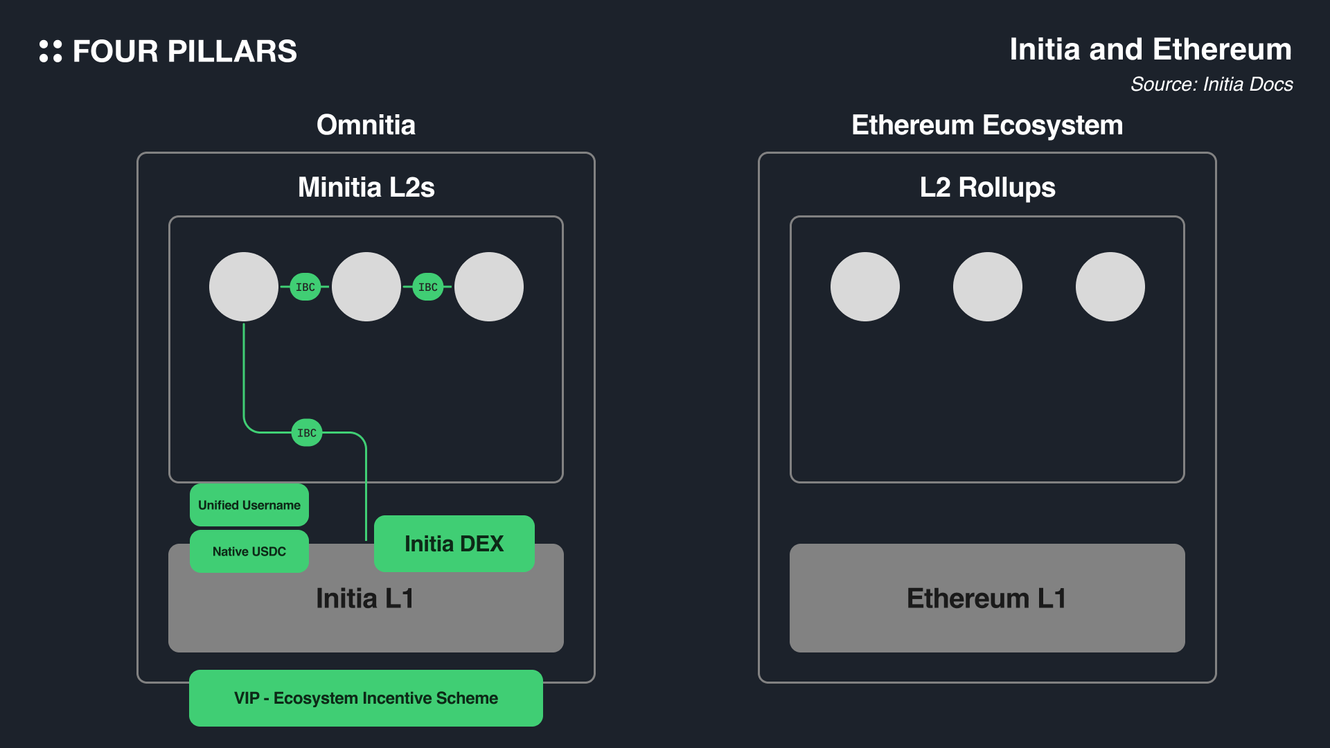
The Ethereum ecosystem is often called as a global settlement layer for decentralized applications and rollups, offering robust infrastructure for the deployment of smart contracts. For scaling solutions, Ethereum relies on Layer 2 systems called rollups, which encompass a diverse array of proof systems and execution environments. Additionally, in Ethereum's L2, sequencers operate independently by the rollup developers to manage transaction ordering, with future developments on the implementation of shared sequencers is ongoing.
In contrast, Omnitia presents itself as an interwoven layer specifically designed for rollups, offering an alternative to Ethereum’s ecosystem. Omnitia's L1, known as Initia, has a Move-based contracts. Omnitia's L2 solution, Minitia, supports multiple virtual machines including MoveVM, EVM, and WasmVM. Its proof system adopts an optimistic model where challenges are resolved by the L1 validators, ensuring consistency and reducing the need for external validation mechanisms. This is important as the rollups can have same trust assumptions between each other.
When it comes to interoperability, Ethereum relies on a mix of third-party bridges and chain abstraction projects. On the other hand, Omnitia integrates IBC for seamless interoperability across different rolups. It is also planning to utilize third-party bridges such as Axelar and LayerZero, enhancing its connection with various blockchain networks and seamless onboarding experience.
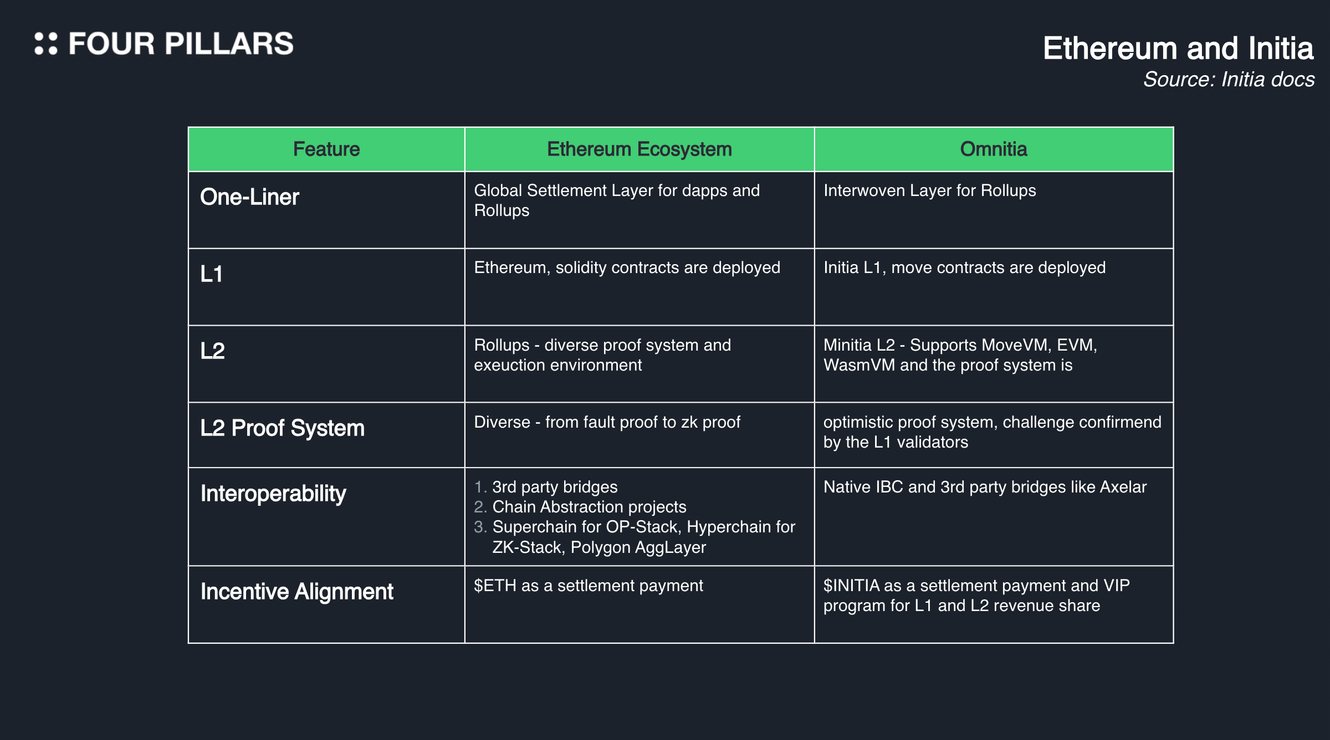
INIT is the native token of the Initia ecosystem, playing a crucial role in various aspects of the network's functionality and economics. Here's an explanation of its utilities:
Staking and Governance: INIT tokens serve as the primary staking asset in the Initia network. Validators and delegators can stake INIT to participate in the consensus process, securing the network and earning rewards. This staking mechanism not only enhances network security but also allows token holders to participate in governance.
Gas Fees and Transaction Costs: As the native token of the Initia network, INIT is used to pay for gas fees and transaction costs within the ecosystem.
The VIP: It is intricately tied to the tokenomics of the $INIT token, playing a crucial role in its design and utility across the Initia ecosystem. Unlike traditional token models that rely on gas fees and burning mechanisms, which often struggle to achieve significant deflationary effects, VIP creates a more robust and multifaceted use case for $INIT. By establishing $INIT as the canonical base token across numerous chains and creating use cases on every L2 product, VIP ensures widespread adoption and demand for the token. This approach not only enhances the token's utility but also strengthens its position in a landscape where L2s can use various tokens for gas. Furthermore, VIP empowers governance by allowing L1 stakers to participate in a gauge system, directing VIP emissions to different L2s. This design addresses challenges faced by other tokens like ATOM, potentially making $INIT a central player in the broader blockchain ecosystem while fostering a more engaged and influential governance model.
Enshrined Liquidity: INIT tokens, either individually or paired with other whitelisted tokens (e.g., INIT-USDC, INIT-stATOM), can be staked with validators to create a liquidity hub within Omnitia. This approach enhances liquidity, improves the user experience, and allows staked assets to generate additional yield through trading fees.
As the app specific rollups are the core driving force of the usage of Initia, it will be important to have diverse projects. There are currently projects that are soon to launch, including perp trading, social dapp, etc. Let’s look into these projects:
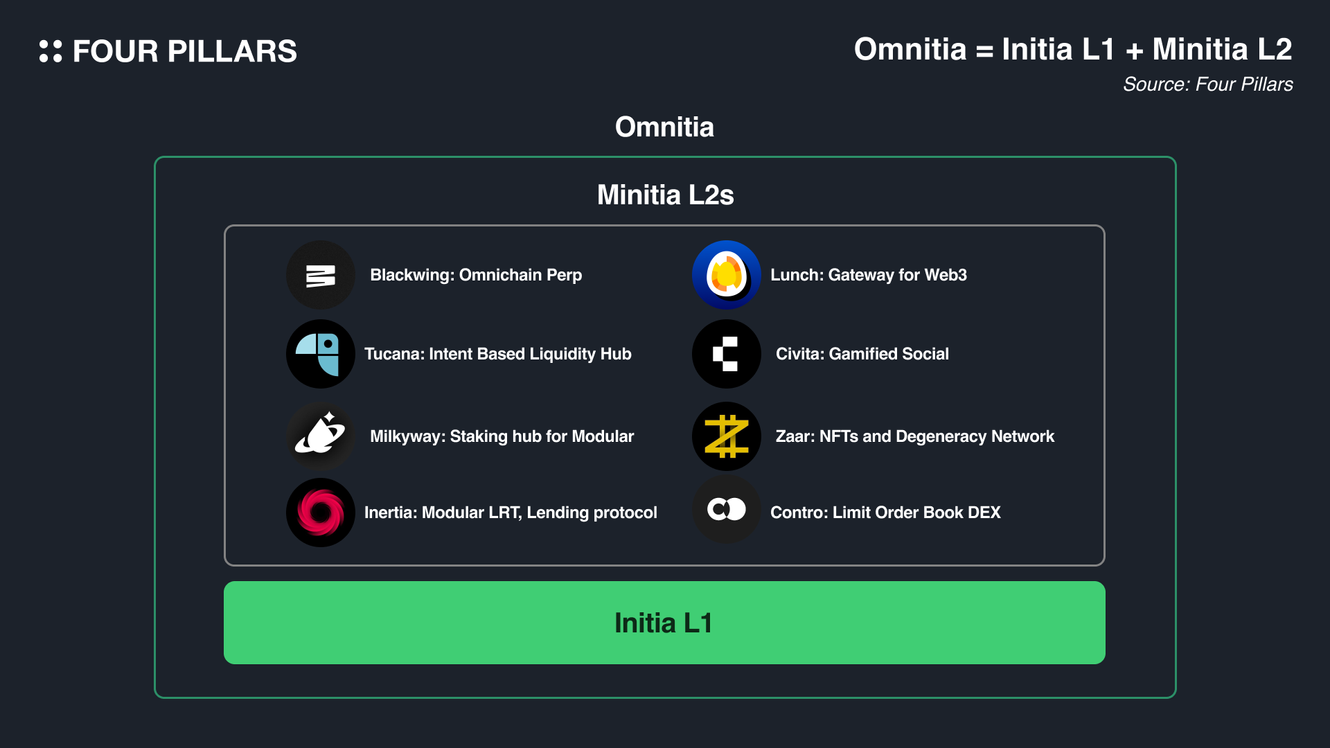
4.2.1 DeFi - Trading
Blackwing - Limitless Pools Perpetuals: Blackwing is a rollup that enables liquidation free leverage trading for long tail assets via a novel construct called Limitless Pools. Additionally, by taking advantage of recent advancements in modular infrastructure and using Initia as a foundation, Blackwing is able to allow users to seamlessly leverage trade any assets from any chain - all without compromising decentralization.
Tucana - Intent Based Liquidity Hub: Tucana is a DEX that utilizes intent-based trading to optimize execution across multiple DEXs and chains. By leveraging advanced routing algorithms and omnichain infrastructure, Tucana allows users to seamlessly access the best liquidity and pricing for their trades, regardless of the asset's native chain.
Contro - Limit Orderbook DEX: Contro is a decentralized limit order book exchange built on an omnichain settlement layer. It offers institutional-grade order matching and execution speeds while maintaining full self-custody of funds.
4.2.2 DeFi - Lending
Inertia - Lending Protocol: Inertia is a lending protocol that enables users to borrow against their cross-chain asset portfolio.
4.2.3 DeFi - Liquid Staking
Milkyway - Liquid Staking Hub: Milkyway is a multi-chain liquid staking solution that allows users to stake assets from various blockchains and receive liquid staking derivatives. Currently Milkyway has over $20M of liquid staked $TIA.
4.2.4 Social
Lunch - Web3 Gateway: Lunch is a decentralized social platform that serves as an entry point for mainstream users into Web3. By combining user-friendly interfaces with blockchain technology, Lunch allows seamless integration of social interactions, content creation, and digital asset management across multiple chains.
Civita - Gamified Social: Civita is a social ecosystem that incorporates gamification elements to incentivize user engagement and community building. Leveraging cross-chain interoperability, Civita enables users to earn rewards, trade digital assets, and participate in governance across various blockchain networks.
4.2.5 NFT
Zaar: Zaar is an omnichain NFT marketplace and creation platform that allows users to mint, trade, and showcase NFTs across multiple blockchains. By utilizing cross-chain infrastructure, Zaar provides a seamless experience for creators and collectors to interact with NFTs.
Will Initia succeed? As there are lots of competition in terms of rollup frameworks, It will be important to have an unique offering. This can range from a business support, a better throughput, and secure environment. What would be the unique offering of Initia? This would be the detailed design on making the most intereconnected rollup ecosystem. The reason why the Initia team has “Interwoven” as the main keyword is that not just interoperability is a core factor in the ecosystem, it has other interconnectivity in terms of economic, liquidity, security, etc.
As app-specific rollups can monetize their user base and build custom infrastructure for their dapps, the need to create individual rollups will continue, and more will be developed. With many options available, as Initia grows its ecosystem and connects with the Ethereum ecosystem, it will become one of the best options for launching a rollup. Initia excels in terms of better developer experience, connectivity with other rollups and ecosystems, and less operational overhead. Initia recently completed their first public testnet successfully, and as they prepare to launch their mainnet, it will be interesting to see how its ecosystem unfolds compared to how Ethereum has developed its rollup ecosystem.
We produce in-depth blockchain research articles

zkRollup is emerging as a major pillar of layer 2 solutions, leveraging the technical advantages of zero-knowledge proofs. It is particularly impressive that Ethereum, which has the largest ecosystem, has officially chosen zkRollup as the direction for its layer 2 rollup. Additionally, Bitcoin is also seeking to achieve scalability by utilizing zkRollup. Following the emergence of Optimistic Rollup, zkRollup has been rapidly growing, offering advantages such as faster processing and lower operational costs. Let's take an in-depth look at zkRollup from its basics to the current market status and future prospects.

Arbitrum and Optimism are striving to improve the technological aspects of fraud proof, while other projects are also implementing interesting approaches. Let's walk through their current activities and ongoing developments.

The strategic decisions and journey of Mantle, from BitDAO's inception to the Mantle V2 upgrade, offer valuable insights into building a successful Layer 2 blockchain.

Currently, most of L2 projects rely on a single sequencer. Metis, as the first L2 chain to decentralize its sequencer structure, has been resolving structural issues stemming from dependency on such single-sequencer structure.